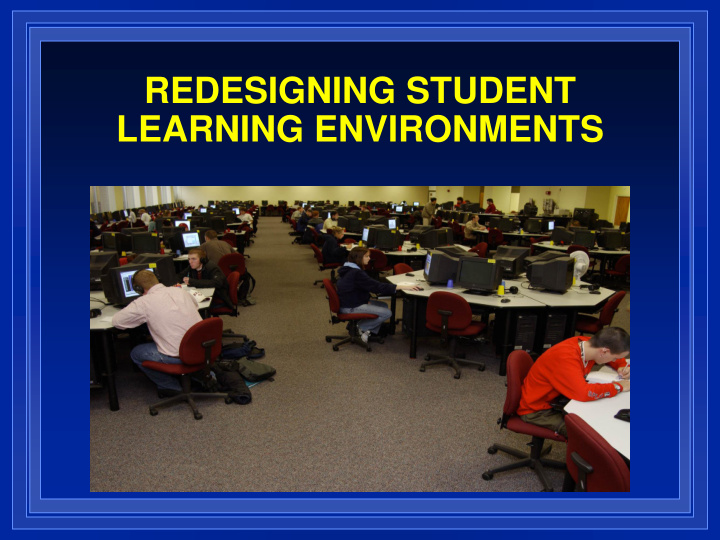



REDESIGNING STUDENT LEARNING ENVIRONMENTS
TODAY’S DISCUSSION Overview of the Methodology and Findings of the Successful Redesign Projects Proven Models for Successful Redesign
• Established in 1999 as a university Center at RPI funded by the Pew Charitable Trusts • Became an independent non-profit organization in 2003 • Mission: help colleges and universities learn how to use technology to improve student learning outcomes and reduce their instructional costs
TRADITIONAL INSTRUCTION Seminars Lectures
“BOLT - ON” INSTRUCTION
WHAT’S WRONG WITH THE LECTURE? • Treats all students as if they are the same • Ineffective in engaging students • Inadequate individual assistance • Poor attendance and success rates • Students fail to retain learning
WHAT’S WRONG WITH MULTIPLE SECTIONS? • In theory: greater interaction • In practice: large class size • In practice: dominated by the same presentation techniques • Lack of coordination • Inconsistent outcomes
WHAT DOES NCAT MEAN BY COURSE REDESIGN? Course redesign is the process of redesigning whole courses (rather than individual classes or sections) to achieve better learning outcomes at a lower cost by taking advantage of the capabilities of information technology.
PROGRAM IN COURSE REDESIGN To encourage colleges and universities to redesign their approaches to instruction using technology to achieve 50,000 cost savings as well as students quality enhancements. 30 projects
SUMMARY OF RESULTS • 25 of the original 30 showed improvement; 5 showed equal learning • 24 measured retention; 18 showed improvement • All 30 showed cost reduction • Results in subsequent national and state and system programs have continued to show comparable results
WHY REDESIGN? Look for courses where redesign will have a high impact – let’s make a difference: • High withdrawal/failure rates • Students on waiting lists • Students turned away – graduation bottleneck • Over enrollment of courses leading to multiple majors • Inconsistency of preparation • Difficulty getting qualified adjuncts • Difficulty in subsequent courses
TEAM EFFORT IS KEY Each team included – Administrator – Faculty experts – Technology expertise – Assessment assistance
NCAT METHODOLOGY: Relevance and Utility • Discipline: math & literature • Age: traditional & working adults • Institution: small & large • Location: on-campus & at a distance • Redesign: current & new courses • Level: introductory & advanced
TAKING COURSE REDESIGN TO SCALE The Roadmap to Redesign • (R2R) 2003 – 2006 (20 institutions) Colleagues Committed to • Redesign (C2R) 2006 - 2009 (60 institutions) Programs with Systems and • States 2006 – present (~80 institutions) The Redesign Alliance • 2006 – present (70+ institutions) Changing the Equation • 2009 – 2012 (38 institutions)
120 REDESIGNED COURSES • 160,000 students nationwide • Improved student learning: 72% Equivalent student learning: 28% • Cost reduction: 37% (9% to 77%) Annual savings: ~$9.5 million • Other outcomes – Increased course-completion rates – Improved retention – Better student attitudes toward the subject – Increased student satisfaction with the mode of instruction
QUANTITATIVE • Statistics • Mathematics – Business Statistics – Developmental Math – Introductory Statistics – Pre-calculus Math – Elementary Statistics – College Algebra – Economic Statistics – Discrete Math • Computing – Introductory Algebra – Computer Programming – Elementary Algebra – Information Technology Concepts – Beginning Algebra – Computer Literacy – Intermediate Algebra – Information Literacy – Linear Algebra – Tools for the Information Age
• SCIENCE • SOCIAL SCIENCE – Anatomy and – American Physiology Government – Astronomy – Macro and Microeconomics – Biology – Psychology – Ethnobotany – Sociology – Chemistry – Urban Affairs – Geology
• PROFESSIONAL • HUMANITIES – Elementary Education – Developmental Reading – Developmental Writing – Education: The Curriculum – English Composition – Engineering – Communication Studies Technology – Understanding the Visual and Performing – Organizational Behavior Arts – Public Speaking – History of Western – Accounting Civilization – Great Ideas in Western – Nursing Music – Spanish – World Literature – British Literature – Women and Gender Studies
WHAT DO THE FACULTY SAY? • “It’s the best experience I’ve ever had in a classroom.” • “The quality of my worklife has changed immeasurably for the better.” • “It’s a lot of work during the transition-- but it’s worth it.”
REDESIGN MODELS • Supplemental – Add to the current structure and/or change the content • Replacement – Blend face-to-face with online activities • Emporium – Move all classes to a lab setting Fully online – Conduct all (most) learning activities online • Buffet – Mix and match according to student preferences • Linked Workshop – JIT workshops linked to college level course
REDESIGN CHARACTERISTICS Redesign the whole course — not just a • single class Emphasize active learning — greater • student engagement with the material and with one another Rely heavily on readily available • interactive software — used independently and in teams Mastery learning — not self-paced • Increase on-demand, individualized • assistance Automate only those course • components that can benefit from automation — e.g., homework, quizzes, exams Replace single mode instruction with • differentiated personnel strategies Technology enables good pedagogy with large #s of students.
SUPPLEMENTAL MODEL • Maintain the basic current structure • Change the content so that more is available on line • Change interaction so that students are interacting more with the material • Change the use of the time to reduce or eliminate lecturing and increase student interaction
BIOLOGY University of Massachusetts CHALLENGES • Inconsistent student preparation • Poor class attendance • Lectures that repeated the contents of the textbook • High dissatisfaction with course by both faculty and students
BIOLOGY University of Massachusetts • Continue to have large class meetings • Require short pre-tests before the start of the first class each week and these are available for the entire term as review • Receive small number of points for taking the online quiz • Provide 24/7 online study materials • Include small group interactions during class focused on applied biology problems • Class periods are now used to discuss biology problems, rather than lecture
BIOLOGY University of Massachusetts Student Outcomes • In spite of more difficult questions, scores on exams in the redesigned course averaged 73% vs. 61% in the traditional course. • 23% of the exam questions in the traditional model required reasoning or problem solving skills vs. 67% in the redesigned course. • Attendance averaged 89.9% in the redesigned course vs. 67% in the traditional course.
REPLACEMENT MODEL • Blend face-to-face with online activities • Determine exactly what activities required face-to-face and reduce the amount of time to focus only on those activities in class • Provide 24/7 online interactive learning materials and resources • Include online self-assessment activities with immediate feedback
FIRST-YEAR SPANISH (Replacement Model) Increase active speaking • via in-class interaction Use technology to • support skill practice Provide immediate • feedback online Increase student and • instructor computer literacy Encourage collaborative • learning, both online and in class
Traditional Redesign • 57 sections (~27) • 38 sections (~54) • Adjuncts + 6 TAs • Instructor-TA pairs • 100% in class • 50% in class, 50% online • $167,074 ($2931/section) • $56,838 ($1496/section) • 1529 students @ $109 • 2052 students @ $28 Oral skills: significantly better performance Language proficiency & language achievement: no significant difference A second Spanish project: final exam scores in speaking, reading and listening were higher
EMPORIUM MODEL • Move all classes to a lab setting • Permit the use of multiple kinds of personnel • Allow students to work as long as they need to master the content • Can be adapted for the kinds of students at a particular institution • Allow multiple courses the same time • Include multiple examples depending upon student interests and majors
MATH TECHNOLOGY LEARNING CENTER Class size increased from 35 to 70, reducing costs by ~30%.
COLLEGE ALGEBRA University of Missouri – St. Louis CHALLENGES • Inconsistent student academic preparation • Success rates sometimes as low as 50% • Inadequate student retention • Inconsistent student outcomes, since taught in multiple sections

Recommend
More recommend